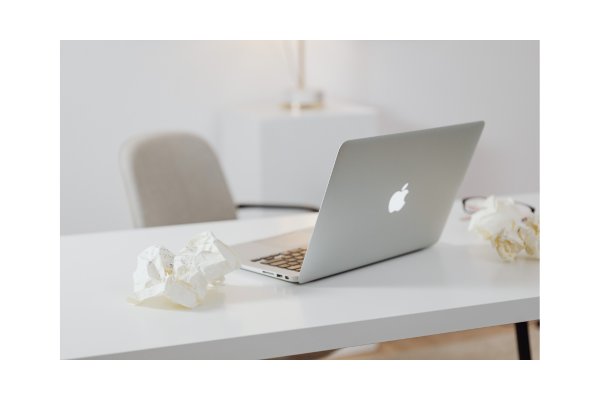
You're juggling payroll, client demands, marketing, and a dozen other priorities. The last thing you want to worry about is cybersecurity—especially when you've always heard that Macs are safe. Here's the reality check that could save your business.
As a woman running a small business, you're already wearing more hats than anyone should have to. Between managing employees, keeping clients happy, handling finances, and trying to grow your company, cybersecurity probably feels like just another item on an impossibly long to-do list. And honestly? You've always been told Macs don't get viruses, so why worry?
The uncomfortable truth is this: that belief could cost you your business.
The "Safe Mac" Myths Are Dangerous
For years, the idea that Macs were immune to cyber threats wasn't entirely wrong. Hackers focused on Windows computers because there were more of them. But that's changed dramatically—and the numbers are worrisome for business owners like you.
Mac-targeted cyber attacks exploded by 400% from 2023 to 2024. We're not talking about a small uptick—this is a massive, coordinated shift by criminals who now see Mac-using businesses as prime targets. They know you believe you're safe, and they're counting on that false confidence.
The criminals aren't just going after big corporations anymore. They specifically target small businesses because they know you're less likely to have expensive security systems in place. About 50% of women business owners have made no real preparations to prevent a cyberattack—and cybercriminals know this.
Myth #1: "Macs Don't Get Viruses"
This is perhaps the most pervasive and dangerous misconception. The belief stems from Apple's early marketing campaigns and the historical reality that fewer viruses targeted Macs due to their smaller market share. However, modern cyber threats extend far beyond traditional viruses to include malware, ransomware, spyware, and sophisticated social engineering attacks that target Mac users specifically.
Myth #2: "Apple's Closed Ecosystem Makes Macs Invulnerable"
While Apple's "walled garden" approach does provide some security benefits, it's far from impenetrable. Recent vulnerabilities have shown that attackers can bypass core macOS security mechanisms.
The closed ecosystem can actually create overconfidence, making users more susceptible to social engineering attacks.
Myth #3: "Low Market Share Means Low Risk"
This argument loses validity as Mac market share continues to grow. More importantly, Mac users often represent high-value targets -- business professionals, executives, and creative professionals with valuable data and financial resources.
What This Really Means for Your Business
Let's talk about what a cyber attack actually costs—not in technical terms, but in real dollars that come out of your business account:
The Overall Financial Hit: When cybercriminals attack your Mac, the average cost to recover ranges from $120,000 to $1.24 million. For most small businesses, that's not just a financial setback—it's potentially fatal. Consider this: 32% of small businesses are at risk of closure from losses as low as $10,000.
The Hidden Costs That Add Up Fast: Beyond the obvious damage, such as a ransom, you're looking at:
-
Lost revenue while your systems are down (average 22 days for recovery)
-
Client trust that takes months or years to rebuild
-
Legal fees if customer data is stolen
-
Compliance penalties that can reach tens of thousands
-
Increased insurance premiums for years afterward
The Survival Statistics
Here's the statistic that should make every business owner pay attention: 60% of small businesses that experience a cyberattack close their doors within six months. This isn't about massive corporations that can absorb the hit—this is about businesses like yours that simply can't survive the financial and operational disruption.
Nearly 1 in 5 small businesses would be forced to close immediately following a successful cyberattack. For businesses with fewer than 100 employees, 32% face immediate closure risk.
Why Mac-Using Businesses Are Prime Targets
Cybercriminals have shifted their focus to Mac-using small businesses for several calculated reasons:
-
You Have Valuable Data: Your customer lists, financial records, and business information are worth money to criminals. They can sell this data or hold it hostage until you pay a ransom.
-
You're Less Protected: While 86% of small businesses have conducted some sort of cybersecurity risk assessment, only 23% feel confident in their protection plans. Most Mac users still rely on the outdated belief that they're automatically safe.
-
You Can't Afford Extended Downtime: Criminals know that small businesses can't survive weeks without access to their files and systems. This makes you more likely to pay ransom demands quickly.
The Types of Attacks Targeting Your Mac Right Now
-
Information Stealers: These programs steal your passwords, customer credit card information, and banking details. The stolen data is sold to other criminals or used to drain your accounts.
-
Ransomware: Your files get locked, and criminals demand payment to unlock them. Even if you pay, there's no guarantee you'll get your data back.
-
Email Attacks: Criminals send convincing fake emails to trick you or your employees into giving up login information or downloading malicious software. These account for 75% of all cyber attacks.
-
Fake Software Downloads: When you search for legitimate business software, criminals buy ads to trick you into downloading infected versions.
-
Cryptomining and Resource Exploitation: Cryptocurrency mining malware has become increasingly prevalent on Macs, taking advantage of powerful Apple Silicon processors. Campaigns distribute mining software through trojanized versions of popular applications like Final Cut Pro, Adobe Creative Suite, and other professional software. The miner, disguised as legitimate system processes, can operate undetected while consuming system resources and degrading performance.
Apple's Built-In Security: Helpful but Not Bulletproof
Apple has implemented multiple security layers, and continues to improve them, but each has limitations that users should understand:
-
Gatekeeper verifies downloaded applications and prevents unknown software from running, but it can be bypassed through social engineering or by convincing users to right-click and open suspicious files.
-
XProtect provides malware detection but only catches known threats and doesn't provide continuous monitoring. It relies on Apple's threat intelligence updates, which may lag a bit behind emerging threats.
-
System Integrity Protection (SIP) protects core system files but doesn't prevent user-level malware or attacks targeting personal data.
-
FileVault offers excellent encryption for data at rest but doesn't protect against malware that executes while the system is unlocked.
Simple Steps That Actually Protect Your Business
The good news? You don't need to become a cybersecurity expert or spend a fortune to protect your business. Here are a few essential steps that will help:
Enable Your Mac's Built-In Protection (5 minutes)
-
Turn on FileVault: This encrypts your hard drive so stolen data can't be read. Go to System Preferences → Security & Privacy → FileVault and turn it on.
-
Enable Automatic Updates: Keep your software current with security patches. Go to System Preferences → Software Update and enable automatic updates.
-
Turn on Your Firewall: This blocks unauthorized access to your computer. Go to System Preferences → Network → Firewall and turn it on.
Protect Your Passwords (10 minutes setup)
-
Use Strong, Unique Passwords: Every account should have a different password. Use a combination of letters, numbers, and symbols.
-
Enable Two-Factor Authentication: This adds an extra security layer to your important accounts. Most banks and business software offer this option. Read more here.
-
Use a Password Manager: Tools like 1Password or LastPass can generate and store strong passwords for you. (See my previous blog post on this, too.)
Get Professional-Grade Protection
-
Install business antivirus or endpoint protection software so you can monitor and protect your devices.
-
Or consider using a managed security service provider to monitor your stuff for you -- it can be more affordable than you'd think.
Back Up Your Business Data
-
Automated Backups: Use Time Machine for local backups and a cloud service for off-site storage. This ensures you can recover even if ransomware encrypts your files.
-
Test Your Backups: Monthly, try restoring a file to make sure your backup system actually works.
Train Your Team (30 minutes quarterly)
-
Email Safety: Teach everyone to verify unexpected emails before clicking links or attachments. When in doubt, call the sender directly.
-
Download Safety: Only download software from official websites or the Mac App Store. Be suspicious of "free" versions of expensive software.
Let's Sum Up: Best Practices for Staying Protected
Download and Installation Habits
-
Only download software from official sources or verified developers.
-
Be extremely cautious with software obtained from torrent sites or unofficial repositories.
-
Always verify the authenticity of software updates, especially unsolicited ones.
-
Pay attention to app permissions and deny unnecessary access requests.
Email and Web Browsing Safety
-
Be skeptical of urgent security warnings or fake Apple support messages.
-
Verify the authenticity of emails claiming to be from Apple by checking your Apple ID account directly (in other words, not by clicking anything in the email).
-
Avoid clicking suspicious links or downloading attachments from unknown sources.
-
Use Safari's built-in security features and keep browsers updated.
Social Engineering Awareness
-
Never provide your Apple ID credentials through pop-ups or unsolicited requests.
-
Be cautious of tech support scams claiming your Mac is infected.
-
Verify the identity of anyone requesting remote access to your computer.
-
Trust your instincts if something seems suspicious or too good to be true.
Making This Manageable
-
Start with the basics: Focus on enabling your Mac's built-in security features and getting business antivirus software. These steps alone will protect you from the majority of attacks targeting small businesses.
-
Consider professional help: Many IT consultants offer small business security packages. The cost is far less than recovering from an attack.
-
Get cyber insurance: Only 17% of small businesses have cyber insurance, but it can cover the costs of recovery and keep you in business.
The Bottom Line for Your Business
Cybersecurity isn't just a technical problem—it's a business survival issue. The criminals targeting Mac-using small businesses are counting on you to believe you're safe while they plan attacks that could close your doors forever.
You don't have to become a cybersecurity expert, but you do need to take basic protective steps now. The 10-15 minutes you spend enabling your Mac's security features and installing business antivirus software could literally save your business.
The mental load you're carrying as a business owner is already heavy—don't let cybercriminals add "business closure" to your list of worries. Take these simple steps today, and you can cross cybersecurity off your worry list while actually protecting what you've worked so hard to build.
Your business, your employees, and your family's financial security depend on recognizing that the "Macs are safe" myth isn't just outdated—in 2025, it's dangerous. The good news? Protecting yourself is simpler and more affordable than you think.


